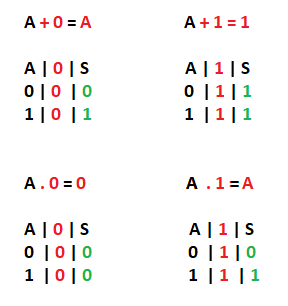How to correctly parse the outputs of the truth tables of Boolean identities?
I can work out the truth tables according to the postulates, but I can't have the analysis view under the truth table output to assert that that answer is actually such.
For example, we have the following postulates below and their respective truth tables:
How can I assert from the outputs of the truth tables that such an answer is the same one?
1 answers
In a true table must be placed rows containing all possible combinations of values for each of the "input"variables. As an example, let's assemble the truth table for Proposition A + B = A:
A | B | A + B |A + B = A
0 | 0 | 0 |1
1 | 0 | 1 |1
0 | 0 | 0 |1
0 | 1 | 1 |0
In this example, the fourth row, containing the combination of input A = 0 and B = 1, results in output 0 (the output is Column A + B = A). That is, the proposition fails for this entry and therefore cannot be true.
Notice that a proposition is only true if when constructing the table with all possible combinations of values for the input variables, no output results in failure.
I believe that your difficulty in understanding the usefulness of tables as a means of proof is because all the expressions you tested are true and very simple expressions, with only one free variable.
For example, imagine an expression with 3 free variables and that you really have no idea if it is false or true. A example:
(A+B)+C.(B+(C+A)) = C+B
The table of this expression will have 8 rows (2^3=8, where 3 is the number of variables). The number of columns will depend on the degree of detail you want for each step of the analysis, but it will probably be several columns.
Well, I think that's it. In your case the expressions are so simple that the table becomes mere observation. Perhaps, using one more column makes the conclusion more explicit (example below), but the large value of the tables you will perceive in more complex expressions and their application in practical problems.
A | B | A + 0 |A + 0 = A
0 | 0 | 0 |1
1 | 0 | 1 |1
